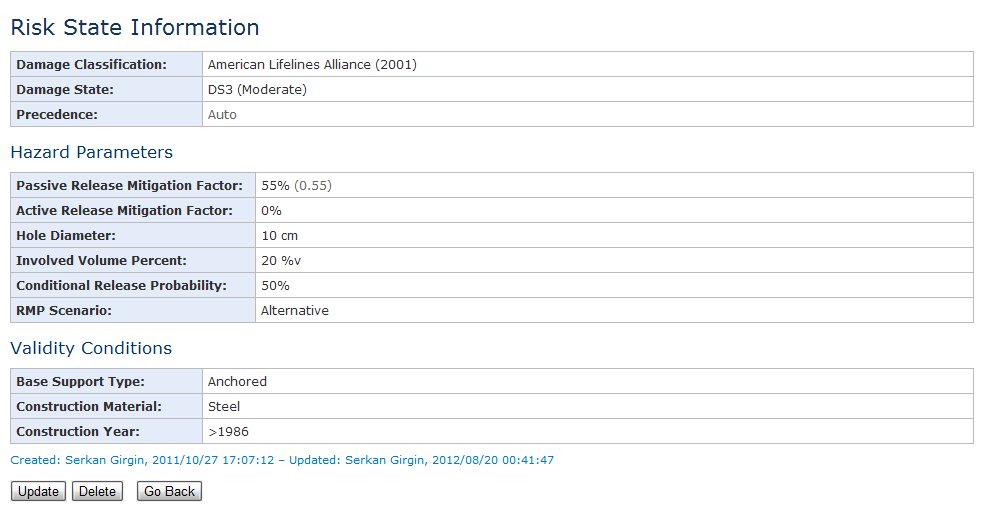Risk States
In order to estimate the risk of natech events (i.e. hazardous chemical releases, fires, and explosions) damage states of plant units, which are calculated from on-site hazard parameters and fragility curves, should be related to appropriate consequence scenarios that can be used for risk assessment. Similar to the simplification applied in describing damage, possible consequence scenarios are also sim-plified as risk states to facilitate the analysis in practice (Salzano et. al, 2003).
Simple one-to-one relations were used in the literature to relate damage states to risk states (Salzano et al., 2003; Fabbrocino et al., 2005). Going one-step further, RAPID-N supports conditional risk state definitions for each damage state. Conditional risk states allow different risk assessment scenarios to be de-fined for a certain damage state, depending on plant unit properties (e.g. storage condition, construc-tion material, volume) and substance properties (e.g. type of substance, boiling point, vapor pressure). RAPID-N stores risk state definitions as risk state records. The data fields of the risk state records are listed in Table 1.
Table 1. Risk state data fields
For each risk state, a damage classification and related damage state should be specified. Damage parameters, which are taken into consideration during consequence analysis and natech risk assessment, can be specified. These parameters include scenario parameters (e.g. U.S. EPA RMP scenario (worst-case or alternative), conditional release probability, atmospheric stability), source-term parameters (e.g. re-lease rate, release duration, hole dimensions, pool area, evaporation rate), and consequence parame-ters (major fire/explosion event (no fire, vapor cloud fire, pool fire, BLEVE, vapor cloud explosion), target endpoint concentration, U.S. EPA RMP reference table). A complete listing of damage parameters is given in Table 4.10.
The possibility to indicate custom damage parameters, such as percent volume of plant unit involved in the event, or conditional release and fire probabilities, allows non-linear damage-risk state relations to be defined in RAPID-N. This results in a more realistic risk assessment, e.g. in the case of damage to piping (generally regarded as a minor structural damage) or elephant-foot buckling with minor loss of content (generally regarded as major structural damage). In these cases, classical damage-risk relations would result in the over- or under-estimation of risk due to their linear behavior where a higher damage state automatically implies a higher risk state. Although this may be correct for economical losses or structural damage, it is not necessarily the case for natech events since the amount of released sub-stance, storage conditions and substance properties also play important roles besides structural damage and affect risk assessment calculations significantly. By specifying a smaller volume involved or release probability values and indicating their validity conditions, such cases can be assessed more adequately in RAPID-N.
In addition to non-linear damage-risk state relations, conditional risk states can also be defined (Figure 1). Similar to the case of property estimators, validity conditions for the risk state can be indicated by selecting the appropriate properties and setting value criteria (see "Property Estimators" section for more details). Because risk states and relevant event scenarios highly depend on plant unit conditions and substance characteristics, both plant unit and substance related properties can be specified as conditional properties. For example, risk states can be defined for atmospheric floating-roof tanks con-structed before a certain year, in which substances with a high heat of combustion are stored. Since conditions with more criteria are preferred over conditions with less criteria according to the condition evaluation algorithm of RAPID-N, detailed risk state definitions are used if they are valid for a given situation. This allows very detailed and case-specific risk states to be defined, without disabling generic risk state definitions applicable to other common situations.

Figure 1. Risk state information
Risk Assessment | Natural Hazards | Industrial Plants | Scientific | Users |
